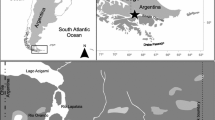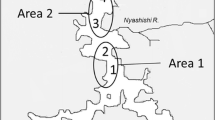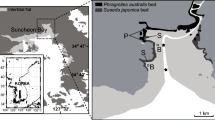Abstract
Stable isotopes are widely used to better understand dietary contributions and trophic interactions in benthic ecosystems. However, the traditional δ13C–δ15N bi-plots can only depict food-web structure for a single time period or space location. Various statistical approaches have now been developed to identify food-web changes in temporal or spatial scale. In the present study, three community-level statistical methods, including circular statistics, Layman et al.’s metrics and Bayesian Ellipses, were applied to compare natural abundance stable carbon and nitrogen isotope data from primary producers, meiofauna (nematodes and copepods), and macrofauna (polychaetes) in an intertidal area between summer and winter. Bayesian mixing model was also used to determine the food source contributions of consumers. In summer, data suggested that benthic microalgae were a dominant food source for most consumers, except for nematode Spilophorella sp. which mainly relied on seagrass detritus. While in winter, there was a significant increase in reliance on seagrass-based carbon for the consumers. The trophic positions of polychaete Eunice sp. and nematode Ditlevsenella sp. also differed between summer and winter, suggesting that they could change their feeding habits and behaviour according to time and availability of food. Using community-based statistics to quantitatively analyze stable isotope data can thus elucidate changes in food-web structure. In addition, considerable variations in food source utilization and trophic level for the same genus or species may imply that the feeding ecology of benthic infauna should be interpreted with caution and cannot be relied on buccal morphology alone.




Similar content being viewed by others
References
Alkemade R, Wielemaker A, de Jong SA, Sandee AJJ (1992a) Experimental evidence for the role of bioturbation by the marine nematode Diplolaimella dievengatensis in stimulating the mineralization of Spartina anglica detritus. Mar Ecol Prog Ser 90:149–155
Alkemade R, Wielemaker A, Hemminga MA (1992b) Stimulation of Spartina anglica leaves by the bacterivorous marine nematode Diplolaimelloides bruciei. J Exp Mar Biol Ecol 159:267–278
Batschelet E (1981) Circular Statistics in Biology. Academic Press, New York
Boecklen WJ, Yarnes CT, Cook BA, James AC (2011) On the use of stable isotopes in trophic ecology. Annu Rev Ecol Evol Syst 42:411–420
Boschker HTS, De Brouwer JFC, Cappenberg TE (1999) The contribution of macrophyte-derived organic matter to microbial biomass in salt-marsh sediments: stable carbon isotope analysis of microbial biomarkers. Limnol Oceanogr 44:309–319
Buffan-Dubau E, Carman KR (2000) Diel feeding behavior of meiofauna and their relationships with microalgal resources. Limnol Oceanogr 45:381–395
Buffan-Dubau E, de Wit R, Castel J (1996) Feeding selectivity of the harpacticoid copepod Canuella perplexa in benthic muddy environments demonstrated by HPLC analyses of chlorin and carotenoid pigments. Mar Ecol Prog Ser 137:71–82
Bunn SE, Loneragan NR, Kempster MA (1995) Effects of acid washing samples on stable isotope ratios of C and N in penaeid shrimp and seagrass: implications for food web studies using multiple stable isotopes. Limnol Oceanogr 40:622–625
Carman KR, Fry B (2002) Small-sample methods for δ13C and δ15N analysis of the diets of marsh meiofaunal species using natural-abundance and tracer-addition isotope techniques. Mar Ecol Prog Ser 240:85–92
Che RGO, Morton B (1991) Spatial and temporal variations in the subtidal microbenthic community of Tai Tam Bay, Hong Kong. Asian Mar Biol 8:193–216
Cheung KC, Wong MH, Yung YK (2003) Toxicity assessment of sediments containing tributyltin around Hong Kong harbour. Toxicol Lett 137:121–131
Chiu HMC, Hodgkiss IJ, Chan BSS (1994) Ecological studies of phytoplankton in Tai Tam Bay, Hong Kong. Hydrobiologia 273:81–94
Cnudde C, Moens T, Willems A, De Troch M (2013) Substrate-dependent bacterivory by intertidal benthic copepods. Mar Biol 160:327–341
Cnudde C, Moens T, Werbrouck E, Lepoint G, Van Gansbeke D, De Troch M (2015) Trophodynamics of estuarine intertidal harpacticoid copepods based on stable isotope composition and fatty acid profiles. Mar Ecol Prog Ser 524:225–239
Couch CA (1989) Carbon and nitrogen stable isotopes of meiobenthos and their food resources. Estuar Coast Shelf Sci 28:433–441
Danovaro R (1996) Detritus–bacteria–meiofauna interactions in a seagrass bed (Posidonia oceanica) of the NW Mediterranean. Mar Biol 127:1–13
Danovaro R, Gambi C (2002) Biodiversity and trophic structure of nematode assemblages in seagrass systems: evidence for a coupling with changes in food availability. Mar Biol 141:667–677
Danovaro R, Scopa M, Gambi C, Fraschetti S (2007) Trophic importance of subtidal metazoan meiofauna: evidence from in situ exclusion experiments on soft and rocky substrates. Mar Biol 152:339–350
De Troch M, Houthoofd L, Chepurnov V, Vanreusel A (2006) Does sediment grain size affect diatom grazing by harpacticoid copepods? Mar Environ Res 61:265–277
Duarte CM (1989) Temporal biomass variability and production/biomass relationships of seagrass communities. Mar Ecol Prog Ser 51:269–276
Dubois S, Savoye N, Grémare A, Plus M, Charlier K, Beltoise A, Blanchet H (2012) Origin and composition of sediment organic matter in a coastal semi-enclosed ecosystem: an elemental and isotopic study at the ecosystem space scale. J Mar Syst 94:64–73
Duplisea DE, Hargrave BT (1996) Response of meiobenthic size-structure, biomass and respiration to sediment organic enrichment. Hydrobiologia 339:161–170
Fauchald K, Jumars PA (1979) The diet of worms: a study of polychaete feeding guilds. Oceanogr Mar Biol Annu Rev 17:193–284
Giere O (ed) (2009) Meiobenthology: the microscopic motile fauna of aquatic sediments, 2nd edn. Springer, Berlin
Ha S, Min WK, Kim DS, Shin KH (2014) Trophic importance of meiofauna to polychaetes in a seagrass (Zostera marina) bed as traced by stable isotopes. J Mar Biol Assoc UK 94:121–127
Heip C, Vincx M, Vranken G (1985) The ecology of marine nematodes. Oceanogr Mar Biol Annu Rev 23:313–328
Herman PJM, Middelburg JJ, Widdows J, Lucas CH, Heip CHR (2000) Stable isotopes as trophic tracers: combining field sampling and manipulative labelling of food resources for macrobenthos. Mar Ecol Prog Ser 204:79–92
Hopkins JB III, Ferguson JM (2012) Estimating the diets of animals using stable isotopes and a comprehensive Bayesian mixing model. PLoS ONE 7:e28478
Jackson AL, Inger R, Bearhop S, Parnell A (2009) Erroneous behavior of MixSIR, a recently published Bayesian isotope mixing model: a discussion of Moore and Semmens (2008). Ecol Lett 12:E1–E5
Jackson AL, Inger R, Parnell AC, Bearhop S (2011) Comparing isotopic niche widths among and within communities: SIBER—Stable Isotope Bayesian Ellipses in R. J Anim Ecol 80:595–602
Jackson MC, Donohue I, Jackson AL, Britton JR, Harper DM, Grey J (2012) Population-level metrics of trophic structure based on stable isotopes and their application to invasion ecology. PLoS One 7:e31757
Jumars PA, Dorgan KM, Lindsay SM (2015) Diet of worms emended: an update of polychaete feeding guilds. Annu Rev Mar Sci 7:497–520
Kaldy JE, Onuf CP, Eldridge PM, Cifuentes LA (2002) Carbon budget for a subtropical seagrass dominated coastal lagoon: how important are seagrasses to total ecosystem net primary production? Estuaries 25:528–539
Kennedy P, Kennedy H, Papadimitriou S (2005) The effect of acidification on the determination of organic carbon, total nitrogen and their stable isotopic composition in algae and marine sediment. Rapid Commun Mass Spectrom 19:1063–1068
Layman CA, Arrington DA, Montaña CG, Post DM (2007) Can stable isotope ratios provide for community-wide measures of trophic structure? Ecology 88:42–48
Lebreton B, Richard P, Radenac G, Bordes M, Bréret M, Arnaud C, Mornet F, Blanchard GF (2009) Are epiphytes a significant component of intertidal Zostera noltii beds? Aquat Bot 91:82–90
Lebreton B, Richard P, Galois R, Radenac G, Pfléger C, Guillou G, Mornet F, Blanchard GF (2011) Trophic importance of diatoms in an intertidal Zostera noltii seagrass bed: evidence from stable isotope and fatty acid analyses. Estuar Coast Shelf Sci 92:140–153
Lebreton B, Richar P, Galois R, Radenac G, Brahmia A, Colli G, Grouazel M, André C, Guillou G, Blanchard G (2012) Food sources used by sediment meiofauna in intertidal Zostera noltii seagrass bed: a seasonal stable isotope study. Mar Biol 159:1537–1550
Leduc D, Probert PK (2011) Small-scale effect of intertidal seagrass (Zostera muelleri) on meiofaunal abundance, biomass, and nematode community structure. J Mar Biol Assoc UK 91:579–591
Lepoint G, Dauby P, Gobert S (2004) Applications of C and N stable isotopes to ecological and environmental studies in seagrass ecosystems. Mar Pollut Bull 49:887–891
Liu XS, Cheung SG, Shin PK (2011a) Response of meiofaunal and nematode communities to sewage pollution abatement: a field transplantation experiment. Chin J Oceanol Limnol 29:1174–1185
Liu XS, Cheung SG, Xu WZ, Shin PKS (2011b) Marine meiobenthic and nematode community structure in Victoria Harbour, Hong Kong upon recovery from sewage pollution. Mar Pollut Bull 63:318–325
Maria TF, Vanaverbeke J, Esteves AM, De Troch M, Vanreusel A (2012) The importance of biological interactions for the vertical distribution of nematodes in a temperate ultra-dissipative sandy beach. Estuar Coast Shelf Sci 97:114–126
Middelburg JJ, Barranguet C, Boschker HTS, Herman PMJ, Moens T, Heip CHR (2000) The fate of intertidal microphytobenthos carbon. An in situ 13C labelling study. Limnol Oceanogr 45:1224–1234
Moens T, Vincx M (1997) Observations on the feeding ecology of estuarine nematodes. J Mar Biol Assoc UK 77:211–227
Moens T, Herman PMJ, Verbeeck L, Steyaert M, Vincx M (2000) Predation rates and prey selectivity in two predacious estuarine nematode species. Mar Ecol Prog Ser 205:185–193
Moens T, Luyten C, Middelburg JJ, Herman PMJ, Vincx M (2002) Tracing organic matter sources of estuarine tidal flat nematodes with stable carbon isotopes. Mar Ecol Prog Ser 234:127–137
Moens T, Bouillon S, Gallucci F (2005) Dual stable isotope abundances unravel trophic position of estuarine nematodes. J Mar Biol Assoc UK 85:1401–1407
Moens T, Vafeiadou AM, De Geyter E, Vanormelingen P, Sabbe K, De Troch M (2014) Diatom feeding across trophic guilds in tidal flat nematodes, and the importance of diatom cell size. J Sea Res 92:125–133
Moore JW, Semmens BX (2008) Incorporating uncertainty and prior information into stable isotope mixing models. Ecol Lett 11:470–480
Morton B, Morton JE (1983) The seashore ecology of Hong Kong. Hong Kong University Press, Hong Kong
Nascimento FJA, Näslund J, Elmgren R (2012) Meiofauna enhances organic matter mineralization in soft sediment ecosystems. Limnol Oceanogr 57:338–346
Ólafsson E, Elmgren R (1997) Seasonal dynamics of sublittoral meiobenthos in relation to phytoplankton sedimentation in the Baltic Sea. Estuar Coast Shelf Sci 45:149–164
Ouisse V, Riera P, Migné A, Leroux C, Davoult D (2012) Food web analysis in intertidal Zostera marina and Zostera noltii communities in winter and summer. Mar Biol 159:165–175
Parnell AC, Inger R, Bearhop S, Jackson AL (2010) Source partitioning using stable isotopes: coping with too much variation. PLoS One 5:e9672
Pinckney JL, Carman KR, Lumsden SE, Hymel SN (2003) Microalgal–meiofaunal trophic relationships in muddy intertidal estuarine sediments. Aquat Microb Ecol 31:99–108
Post DM (2002) Using stable isotopes to estimate trophic position: models, methods, and assumptions. Ecology 83:703–718
Ratsimbazafy R, Boucher G, Dauvin JC (1994) Mesures indirectes de la biomasse des nématodes du méiobenthos subtidal de la Manche. Cah Biol Mar 35:511–523
Riera P, Richard P, Grémare A, Blanchard G (1996) Food source of intertidal nematodes in the Bay of Marennes-Oleron (France), as determined by dual stable isotope analysis. Mar Ecol Prog Ser 142:303–309
Rooney N, McCann K, Gellner G, Moore JC (2006) Structural asymmetry and the stability of diverse food webs. Nature 442:265–269
Rysgaard S, Christensen PB, Sørensen MV, Funch P, Berg P (2000) Marine meiofauna, carbon and nitrogen mineralization in sandy and soft sediments of Disko Bay, West Greenland. Aquat Microb Ecol 21:59–71
Rzeznik-Orignac J, Boucher G, Fichet D, Richard P (2008) Stable isotope analysis of food source and trophic position of intertidal nematodes and copepods. Mar Ecol Prog Ser 359:145–150
Schmidt SN, Olden JD, Solomon CT, Vander Zanden MJ (2007) Quantitative approaches to the analysis of stable isotope food web data. Ecology 88:2793–2802
Schratzberger M, Ingels J (2017) Meiofauna matters: the roles of meiofauna in benthic ecosystems. J Exp Mar Biol Ecol. https://doi.org/10.1016/j.jembe.2017.01.007
Shin PKS, Huang ZG, Wu RSS (2004) An updated baseline of macrobenthic infauna in subtropical waters of Hong Kong. Mar Pollut Bull 49:128–135
Solomon CT, Carpenter SR, Clayton MK, Cole JJ, Coloso JJ, Pace ML, Vander Zanden MJ, Weidel BC (2011) Terrestrial, benthic, and pelagic resource use in lakes: results from a three-isotope Bayesian mixing model. Ecology 92:1115–1125
Somerfield P, Warwick RM, Moens T (2005) Meiofauna techniques. In: Eleftheriou A, McIntyre A (eds) Methods for the study of marine benthos, 3rd edn. Blackwell Science Ltd, Oxford, pp 229–272
Vafeiadou AM, Adão H, De Troch M, Moens T (2013) Sample acidification effects on carbon and nitrogen stable isotope ratios of macrofauna from a Zostera noltii bed. Mar Fresh Res 64:741–745
Vafeiadou AM, Materatski P, Adão H, De Troch M, Moens T (2014) Resource utilization and trophic position of nematodes and harpacticoid copepods in and adjacent to Zostera noltii beds. Biogeosciences 11:4001–4014
Valentine JF, Heck KL Jr (1999) Seagrass herbivory: evidence for the continued grazing of marine grasses. Mar Ecol Prog Ser 176:291–302
Van Oevelen D, Soetaert K, Middelburg JJ, Herman PM, Moodley L, Hamels I, Moens T, Heip CH (2006) Carbon flows through a benthic food web: integrating biomass, isotope and tracer data. J Mar Res 64:453–482
Van Oevelen D, Bergmann M, Soetaert K, Bauerfeind E, Hasemann C, Klages M, Schewe I, Soltwedel T, Budaeva NE (2011) Carbon flows in the benthic food web at the deep-sea observatory HAUSGARTEN (Fram Strait). Deep Sea Res I Oceanogr Res Pap 58:1069–1083
Vander Zanden MJ, Rasmussen JB (2001) Variation in δ15N and δ13C trophic fractionation: implications for aquatic food web studies. Limnol Oceanogr 46:2061–2066
Vizzini S, Sarà G, Michener RH, Mazzola A (2002) The role and contribution of the seagrass Posidonia oceanica (L.) Delile organic matter for secondary consumers as revealed by carbon and nitrogen stable isotope analysis. Acta Oecol 23:277–285
Wainright SC, Weinstein MP, Able KW, Currin CA (2000) Relative importance of benthic microalgae, phytoplankton and the detritus of smooth cordgrass Spartina alterniflora and the common reed Phragmites australis to brackish-marsh food webs. Mar Ecol Prog Ser 200:77–91
Warwick RM (1984) Species size distributions in marine benthic communities. Oecologia 61:32–41
Warwick RM, Collins NR, Gee JM, George CL (1986) Species size distributions of benthic and pelagic Metazoa: evidence for interaction? Mar Ecol Prog Ser 34:63–68
Wieser W (1953) Die Beziehungen zwischen Mundhöhlengestalt, Ernährungsweise und Vorkommen bei freilebenden marinen Nematoden. Eine ökologisch-morphologische Studie. Ark Zool 4:439–484
Xu WZ, Cheung SG, Shin PKS (2014) Structure and taxonomic composition of free-living nematode and macrofaunal assemblages in a eutrophic subtropical harbour, Hong Kong. Mar Pollut Bull 85:764–773
Acknowledgements
We thank Dr. Xiaoshou Liu for his advice on meiofaunal sampling and Ankang Teng for his technical assistance in the field and laboratory. Constructive comments from reviewers are much appreciated.
Author information
Authors and Affiliations
Corresponding author
Ethics declarations
Funding
This study is supported by a General Research Fund (Project No. CityU 161009) from the Research Grants Council of the HKSAR Government and research fund from the Foundation of Tianjin Key Laboratory of Marine Resources and Chemistry (Tianjin University of Science and Technology), People’s Republic of China (No. 201506).
Conflict of interest
The authors declare that they have no conflict of interest.
Ethical approval
All applicable international, national, and/or institutional guidelines for the care and use of animals were followed.
Additional information
Responsible Editor: M. Huettel.
Reviewed by A.-M. Vafeiadou and undisclosed experts.
Electronic supplementary material
Below is the link to the electronic supplementary material.
Rights and permissions
About this article
Cite this article
Xu, WZ., Cheung, S.G., Zhang, ZN. et al. Dual isotope assessment of trophic dynamics of an intertidal infaunal community with seasonal shifts in food sources. Mar Biol 165, 21 (2018). https://doi.org/10.1007/s00227-017-3278-7
Received:
Accepted:
Published:
DOI: https://doi.org/10.1007/s00227-017-3278-7




